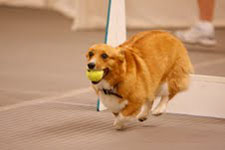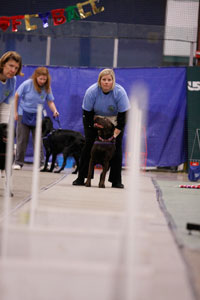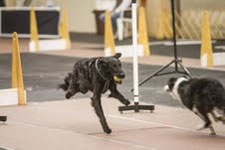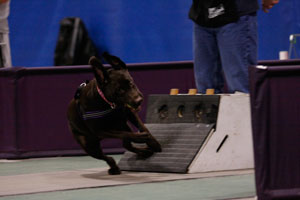Flyball—what is it and where did it come from?
Controlled chaos! Drag racing for dogs! These are some of the phrases used to describe flyball—a relay race for dogs and their humans.
Flyball began in the 1980s as an offshoot of scent hurdling (a sport that was itself started in the 1960s). In scent hurdling, a team of four dogs and handlers races against other teams. The object is to see which team can be the first to send all their dogs over four jumps to retrieve scented dumbbells and return with the correct dumbbell.

Photo courtesy of Jim Geiser
of Game Time Photography
For fun, one team had someone toss tennis balls for the dogs to retrieve instead of scent articles. Herbert Wagner is credited with designing the first flyball box where a spring-loaded mechanism replaced the person throwing the tennis ball—and the rest is history.
There are currently two organizations in the United States that sanction flyball competition: North American Flyball Association (NAFA), established in 1984, and United Flyball League International (U-FLI), created in 2004. Flyball is truly an international sport with competitions in Australia, Europe, and South Africa. Countries, including Belgium, Finland, Germany, Poland, and the United Kingdom, compete in an annual European championship as well. Flyball is a sport for any dog, since the associations that sanction competition allow mixed as well as purebred dogs to compete.
How to play

Photo courtesy of Jim Geiser
of Game Time Photography
So, what do participants do in flyball?
At NAFA-sanctioned tournaments, teams of four dogs with up to two alternates are assigned to divisions to race. Tournament formats vary, but the course the dogs run is always the same: 51 feet from the start line to the flyball box with four jumps in between.
Each of the four dogs on the team must run over the jumps, trigger the flyball box to release a ball, get the ball, and return with the ball back over all four jumps. Except for the first dog in the lineup, no dog can cross the start/finish line until the dog before returns. If a dog makes an error, that dog must run the course again. The first team to have all four dogs complete the course successfully wins the race.
Jump heights range from 7 to 14 inches in NAFA competition (other sanctioning organizations have different jump-height ranges). Height is based on the height of the dog at the withers, rounded down to a whole number minus 5 inches. The height for the entire team is set by the shortest dog running in the lineup. This makes small dogs (known as "height dogs") a valuable asset in the flyball world.
When flyball started, all the judging was handled by humans. Heats were timed by hand with stopwatches, and all the passes and starts were called by a person with a red flag. The judge started each heat with "ready, set, go" and a whistle. As teams have become faster and as technology has changed, timing of heats, calling passes between the dogs, and starting the race are now done by electronic systems at most tournaments.
A set of lights runs through a cadence of yellow lights followed by a green light to start the race. A false start or an early pass results in a red light and an error; the dog has to run again. (The mistake is usually the fault of the handler, who releases the dog too soon and causes the actual error.) Electronic timers record the times of individual dogs, as well as the team total, and times are measured to the thousandths of a second. The NAFA world record is 15.093 seconds (held by Rocket Relay) and the U-FLI record is 14.690 seconds (held by Touch N Go). Note that U-FLI has the same length course as NAFA, but slightly different jump height rules.

Photo courtesy of Sam Bennett
of Swift-Bennett Photography
At tournaments, teams compete for placements against other teams in their division based on seed times submitted before the tournament. They also compete against the clock to earn points toward titles. Each of the four dogs racing on the team in a heat earns points based on the team's time. Under NAFA rules, a time under 32 seconds earns 1 point, a time under 28 seconds earns 5 points, and a time under 24 seconds earns 25 points. Titles begin at Flyball Dog (20 points) and go up to Hobbes (100,000 points—a lot of racing!). Currently, the highest-pointed dog in NAFA racing has more than 150,000 points.
When flyball began, you had to be a member of a team to compete at a tournament. Changes over the years now allow for pick-up teams. U-FLI has competition categories for single dog and pairs racing in addition to the traditional four-dog teams.
Get started—with "dead ball" games
If you want to become involved with flyball, searching for a club and classes in your area is a fine first step. Look on the sanctioning organizations' websites to find tournaments to watch, and to meet folks involved in the sport. Most clubs train flyball skills using positive reinforcement and some form of mark-and-reward, but it never hurts to ask to make certain.
At flyball practices, as well as at tournaments, there can be lots of down time between exercises and heats. Teaching your dog to rest comfortably in a crate provides a good way to relax between runs during what can be very long days at a tournament. If your dog is not 100% comfortable resting in a crate, work on that behavior as you begin to get involved with flyball.
Lots and lots of folks involved in flyball got started because they had dogs that "loved tennis balls." While that interest gets some people started, it certainly is not a necessity. You can train a retrieve even if your dog isn't crazy about balls. In fact, many dogs that are ball-crazy lose interest when the ball stops moving (the ball is just sitting there in the box when the dog goes to get it during a flyball race). Having a dog that loves chasing a tennis ball does not guarantee that teaching the game will be easy.
A good way to start training for flyball at home is to teach your dog to bring you a ball when it is stationary. If your dog likes to chase balls that are moving, roll the ball a short distance and wait until it stops before releasing your dog to get it. Another good exercise is to place a ball on the ground and move a few steps away before sending your dog to retrieve the ball.
While it is not necessary for the dog to deliver the ball to your hand, it does help to reinforce for bringing the ball near you. This practice discourages the dog from dropping the ball early during a race. In competition the dog must bring the ball back over all four jumps and across the finish line before dropping it.
Wanted: recall skill and focus around distractions

Photo courtesy of Jim Geiser
of Game Time Photography
While many dogs have worked with low-level distractions, it's almost impossible to simulate the level of distraction that takes place during a flyball tournament. Try to imagine seven other dogs running around, many of them barking, people running back and forth—and possibly even eight other dogs and handlers running in another set of racing lanes just a few feet away! Flyball tournaments tend to be really active, noisy places.
The more training you can do around distractions, both motion and noise distraction, the easier it will be for your dog to understand the need to focus on you in that environment.
A solid foundation on recalls is also important. After all, as soon as the dog retrieves the ball, you want the dog to run back to you as fast as possible.
Jumping
Jumping is a huge part of the flyball game. The dog must go over four jumps each way—to and from the flyball box. Jumps in competition are 24" wide between the uprights, but you can begin working on jumping skills with your dog with jumps of any width. If you have someone to work with during your training, practice restrained recalls over the jumps to build drive and speed.
If your dog catches on to the dead ball games, place the ball on the other side of one jump and release your dog to get the ball and bring it back over the jump. Barriers or ring gates can be used to create a jump chute that will help your dog experience success going over jumps in early training. As the dog gets better at the game, keep adding jumps until the dog goes over four jumps to the ball and returns over the jumps carrying the ball back to you.
How about a game of chase?
During flyball competitions you will frequently see handlers turn and run away from their dogs when the dogs are returning from the box with the ball. Chase games during training build the drive to run after the handler on the return from the box, helping to speed up the dog's overall run.
Or a game of tug?
Reinforcement for a good run is common in flyball. You are allowed to bring food into the racing lanes, so some handlers choose to reinforce their dogs using treats. Others use a tug toy and a brief game of tug as the dog's reinforcer before the next heat. If you have a dog that enjoys tugging, incorporate tugging into other training games as a reinforcer. This expectation of a tug reward after a successful game is helpful if you plan to use a game of tug as your reinforcer in the racing lanes.
Conditioning
Flyball is a very athletic sport. At tournaments, teams may run 18 to 24 heats a day. When you add in reruns for false starts, early passes, or other errors, a dog can run 40 to 50 times or more in a weekend. To help the dog run as fast at the end of the weekend as at the start, it is important to keep the dog conditioned. Trotting or swimming for endurance, sprints (like fetch games) for speed, and exercises for strength to build the dog's core muscles are all important parts of a balanced conditioning program.
Not your basic box

Photo courtesy of Jim Geiser
of Game Time Photography
Other flyball skills (box work and passing) require more specialized equipment to train, as well as coaching from someone with experience. The current styles of flyball boxes can be built by someone with experience in woodworking from plans that are available online, or flyball boxes can be purchased for $500 and up.
What started as a catapult that flung the ball high into the air has evolved into a precise piece of equipment with machined parts for consistent throws and a hair-trigger response when the dog hits the box to release the ball. Team members usually purchase the boxes together and share use of them, both for training and at competitions.
The original catapult-style box resulted in dogs jumping and twisting at odd angles to get the ball, which had the potential to cause injury during the race. Over time, different styles of boxes were developed. The "wedge" box made the entire front of the box the trigger with a hole in the upper center where the ball came out. This redesign got rid of the twisting and jumping while trying to get the ball, but created a "smash and grab" situation where dogs hit the box straight on to trigger it from a full-out run down the lanes.
The change to a wider box and a "vertical front," and innovations in the behaviors the dogs were trained to perform, resulted in a "swimmer's turn" off the box. Dogs bank off the face of the box and trigger it as they change direction for the return to their handler.
Passing has evolved as well. Early races were run with the dogs released from a sit right at the start line. Teams now release dogs from up to 65 feet from the start/finish line so that the dog is running full out entering the jumps and passing the returning dog.
Teaching dogs to run and pass at full speed, in a pattern that avoids collisions between the dogs, requires the skill of a flyball veteran. Seek advice from and train with someone who has experience in flyball and in preparing for the sport.
Doing what you and your dog love = the true reward
A true team sport, flyball requires the cooperation of four to six dog/handler teams, as well as additional help to compete. Consider these team members: a box loader to load each ball in the box, ball shaggers to pick up the balls after the run, pass callers to help the handlers release the dogs at just the right moment (trying for a nose-to-nose pass right at the line), and stat writers to track how the dogs and team do time-wise over the tournament.
There are as many reasons to play flyball as there are people competing! Finding a team of like-minded individuals can be key to enjoying the sport. Some teams race to be top in the tournament, always trying for first place in the top division. Others want to run fast and clean to accumulate points toward titles. Still others just want to have a good time doing something they love along with other dog folks.
Teams generally crate together at tournaments and it is not uncommon to see expansive spreads of food shared over the course of the weekend. Flyball can be as much about the social aspect of the weekend as the competition.
Getting together with people who love dogs and flyball, and who enjoy each other's company, is always a pleasure and positive experience. Maybe I'll see you in the racing lanes!
Related Products
|
|
|






Post new comment